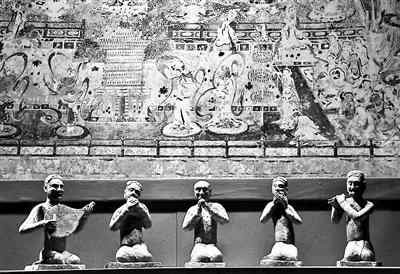Reunion in Dunhuang at the Forbidden City after 70 years
On September 17, "Dun Xing Gu Yuan: The Palace Museum Dunhuang Special Exhibition" opened in the Palace Museum.
This exhibition is sponsored by the Ministry of Culture and Tourism and the People's Government of Gansu Province, and undertaken by the Palace Museum and Dunhuang Research Institute.
The exhibition is located in the Meridian Hall of the Palace Museum, and is open to the audience from the afternoon of September 17th to November 18th.
In the 1950s, the Dunhuang Academy held an exhibition at the Meridian Gate of the Forbidden City.
Today, 70 years later, the Forbidden City and Dunhuang once again meet. Two cultural monuments, with their unique charms that transcend time and space and blend ancient and modern, let the audience deeply feel the great integration, creativity and vitality of the Chinese nation.
According to reports, this exhibition is divided into three units: "The Silk Road, the World", "The World of Vientiane," and "Protection and Inheritance". A total of 188 cultural relics from the Gansu section of the Silk Road and the Palace Museum are on display.
The exhibits also include 35 copies of Dunhuang murals, 6 reproductions of colored sculptures, more than 70 copies of high-fidelity digital murals, and more than 20 auxiliary exhibits such as imitation canopies and pagodas.
In the temporary exhibition hall under the West Horse Road, Wumen, three replicated caves of Dunhuang Mogao Grottoes 285, 220 and 320 are also exhibited, allowing the audience to experience up close the two major representatives and cultures that have gathered together as a thousand-year-old Chinese civilization. Two bases for heritage protection research and utilization-the unique charm of Dunhuang Grottoes and the Forbidden City.
Lou Jie, one of the research librarians and exhibition planners of the Art Research Department of Dunhuang Academy, introduced that the "Silk Road Replenishment" part of Xiyanchi Tower is composed of "Silk Road Walk", "Constitution", "Solemn Pure Land" and "On the Wall" "Danqing" is composed of four parts, with a large number of Silk Road cultural relics, Dunhuang murals and sculpture copy works to show the history of Dunhuang development on the Silk Road, the construction of grottoes and the art of mural sculpture; the "Vientiane World" part of the Wumen exhibition hall is composed of "Neon Clothes and Beauty". It consists of six parts: "Miao Music Dance", "Pattern Huazhang", "Ingenuity Creation", "A Variety of Human World" and "All Things Are Feeling". High-definition digital images are selected from the Dunhuang grotto murals to showcase the comprehensiveness of Dunhuang culture and art for more than a thousand years. The “Protection and Inheritance” unit of the East Yanchi Tower is divided into the Forbidden City chapter and the Dunhuang chapter. Typical examples of heritage protection, cultural exchanges, and technological innovation of the two hospitals are selected respectively, and precious files, images, documents and cultural relics are used as carriers for display The two institutes have made important achievements in the process of heritage protection and cultural development.
Text/Reporter Wang Yan
Photography/Reporter Wang Xiaoxi

